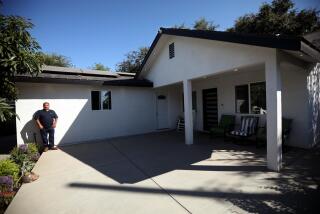Housing Permits in Orange County Fall to an 8-Year Low
Housing permits issued in Orange County last year fell to the lowest level since 1982, and the value of new commercial projects dipped to a seven-year low, as the local construction industry approached the bottom of yet another boom-and-bust cycle.
According to the Construction Industry Research Board in Burbank, Orange County residential builders pulled permits for just 11,975 homes and apartments in 1990, down 28.2% from 1989. That is the least number of permits issued since the last recession.
Commercial and industrial builders fared little better. For 1990, the value of new office and industrial construction in the county dropped 31.2% when adjusted for inflation, to $677.1 million from $984.2 million in 1989.
The value of new residential construction permits plummeted even further. They were off 43.6%, to $1.16 billion from $2.06 billion in 1989--a year in which building activity had already declined dramatically from the boom of 1987-88.
For December alone, county builders took out permits for 321 residential units, down 82% from 1,807 units a year earlier. Just 73 single-family dwelling permits were issued for the month, an 89.4% decline from 690 in December, 1989.
Some analysts do not believe that the local industry has yet hit bottom. âWe will continue to see a decline in construction activity until the latter part of 1991,â said Michael Meyer, a construction industry specialist with the accounting and consulting firm of Kenneth Leventhal & Co. in Newport Beach.
The construction slump has already resulted in thousands of layoffs and stopped residential and commercial building in many county areas. But some industry officials also see a positive side to the current downturn.
âIt was a year of good and bad,â Meyer said. âThe slowdown will have a positive impact by bringing the supply down to match demand and causing home builders to go back to the drawing board and design homes that sell for less than $300,000.â
The move to prop up the market by dropping prices is illustrated by board figures showing that the decline in residential permit values outpaced the decline in the number of permits issued. The reason: Builders switched to smaller homes and lots last year to reduce housing prices.
The permit values reflect the cost of labor and materials but do not take into account the price of land or a developerâs profit, said Ben Bartolotto, the boardâs research director.
Because permits are generally issued three to six months before a developer begins construction, the number of housing permits and value of non-residential permits issued each year are considered a reliable early indicator of the future health of the construction industry.
The 1990 figures--especially the housing permit totals for the final quarter--underscore economistsâ predictions that it will be at least mid-1991 before a recovery can begin in the construction industry.
The residential, commercial and industrial construction industries have been plagued by many of the same things:
* The economy started slipping early in the year, and some economists say it dipped into a mild recession early in the fourth quarter.
* Lenders, already under the gun from federal regulators to strip their portfolios of speculative or high-risk loans and investments, grew loath to make building and land-acquisition loans.
* Economic uncertainty grew in reaction to the Iraqi invasion of Kuwait, prompting home buyers to pull out of the market and businesses to put off expansions and relocations, further depressing residential sales and commercial leasing.
Christine Reed, executive director of the county chapter of the Building Industry Assn., said the drop in residential permits is happening nationwide and was âa major topic of conversationâ at the recent National Assn. of Home Builders conference in Atlanta.
âThere is cause for alarm,â she said. âA credit crunch, a lack of buyers and economic caution by what buyers there are all add up to continued sluggishness.â
Not all builders have withdrawn from the residential market, but the number of permits issued in the last few months clearly shows that the county is heading for another housing shortage such as the one that drove prices up in the late 1980s, Reed said.
âWe have a lack of demand right now, but when demand picks up--and it will--there will be a lack of new homes, and that will drive prices up,â she said.
Just 3,419 permits were issued for single-family homes in 1990, down 57.4% from 8,029 units in 1989. The value of those permits, $607.6 million, was off 57% from $1.4 billion a year earlier.
Builders in the county also obtained permits for 8,556 multiple-family homes--apartments, townhouses and condominiums--in 1990, down just 0.6% from 8,608 units in 1989. But multiple-family permit values dropped 12%, to $553.1 million from $627.8 million, as builders shifted away from higher-price condominiums and luxury apartments into smaller units with lower price tags, with the object of bringing buyers back to a sagging market.
The decline in residential permit activity in the county began in June but was especially strong in the last three months of the year, the research boardâs figures show. The trend continued in December, with the strong drop in permits issued for both single-family and multifamily units.
In the commercial and industrial arena, the number and scope of projects withered as vacancy rates hovered in the stratosphere all year long: about 23% for offices and 15% for industrial buildings.
The research board report shows that the $61.4-million value of new industrial construction for which permits were issued in 1990 was the lowest since record-keeping began in 1967. The next-lowest annual total, adjusted for inflation, was $120.5 million in 1983. Industrial permit values in 1990 fell 58.9%, from $149.5 million in 1989.
Commercial permit valuation for new construction dropped 26.2%, to $615.7 million last year from $834.6 million in 1989. The valuation figure also was the lowest since 1983, when the inflation-adjusted total was $499.4 million.
Looking For The Bottom Key indicators for the future of construction in the housing commerical and industrial sectorsreached the lowest points in 1990 since the end of the last recession. New Housing Units The number of permits issued for new homes in the county was the lowest in eight years, and fourth lowest since record-keeping began in 1967. â68: 12, 307 â90: 11, 975 New Commercial Building The value of commerical building permits fell to a seven-year low in 1990, but remained well above levels in the years prior to the 1980-82 recession. (Figures expressed in thousands of 1990 dollars) â68: $291,223 â90: $615,700 New Industrial Building The value of industrial building permits fell to a 24-year low in 1990, amounting to only half the next-lowest total, posted in 1982. (Figures expressed in thousands of 1990 dollars) â68: $150,872 â90: $61,407 Source: Construction Industry Research Board
More to Read
Sign up for Essential California
The most important California stories and recommendations in your inbox every morning.
You may occasionally receive promotional content from the Los Angeles Times.






